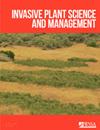Effects of Ventenata dubia removal on rangelands of northeast Wyoming
IF 1.2
4区 生物学
Q3 PLANT SCIENCES
引用次数: 7
Abstract
Abstract Ventenata [Ventenata dubia (Leers) Coss.] is one of several annual grass invaders of the western United States. Ventenata dubia is documented reducing the forage availability for livestock and wildlife as well as lowering biodiversity in the Great Basin. This species has recently spread to the Great Plains, where it could bring these impacts with it. We attempt to answer questions on whether or not conservation practices, in this case removal of V. dubia with herbicide, result in recovery of forage resources and biodiversity. We answer these questions by measuring biomass, cover, and nutrient content 1-yr posttreatment at 9 sites in Sheridan County, WY, conducted in two years. Perennial grasses have higher crude protein and total digestible nutrients than V. dubia, and removal of V. dubia resulted in a positive perennial grass response both years. Further, the differences in pattern of growth between perennial and annual species, with annual grasses quickly senescing early in the year, make perennial grasses a more dependable forage base with higher available nutrients. Interestingly, total biomass and nutrient mass did not change after V. dubia removal due to equal replacement with perennial grasses. Species richness and diversity were unaffected by removal of V. dubia. Our results suggest that managing invasive annual grasses, particularly V. dubia, in the Northern Great Plains can improve forage resources for livestock and wildlife while maintaining species diversity. Therefore, proactive monitoring and management efforts to prevent spread should be prioritized in this region.清除怀俄明东北部放牧区丘比塔的影响
文特纳塔[文特纳塔杜比亚(Leers)Coss.]是美国西部的几种一年生草地入侵者之一。据记载,Ventenata dubia减少了牲畜和野生动物的饲料供应,并降低了大盆地的生物多样性。该物种最近已经扩散到大平原,在那里它可能会带来这些影响。我们试图回答这样一个问题,即保护措施,在这种情况下,用除草剂清除杜布病毒,是否会导致饲料资源和生物多样性的恢复。我们通过在两年内在怀俄明州谢里丹县的9个地点测量处理后1年的生物量、覆盖率和营养成分来回答这些问题。多年生草本植物的粗蛋白和总可消化营养物质比杜比草高,去除杜比草两年都能使多年生草本植物产生积极的反应。此外,多年生和一年生物种之间的生长模式差异,一年生草在一年中的早期迅速衰老,使多年生草成为更可靠的饲料基地,具有更高的可用营养。有趣的是,由于多年生草本植物的同等替代,去除杜布后总生物量和营养物质质量没有变化。物种丰富度和多样性不受杜贝去除的影响。我们的研究结果表明,在大平原北部管理入侵的一年生草本植物,特别是杜比亚,可以改善牲畜和野生动物的饲料资源,同时保持物种多样性。因此,预防传播的积极监测和管理工作应在该地区得到优先考虑。
本文章由计算机程序翻译,如有差异,请以英文原文为准。
求助全文
约1分钟内获得全文
求助全文
来源期刊

Invasive Plant Science and Management
PLANT SCIENCES-
CiteScore
2.20
自引率
9.10%
发文量
24
审稿时长
6-12 weeks
期刊介绍:
Invasive Plant Science and Management (IPSM) is an online peer-reviewed journal focusing on fundamental and applied research on invasive plant biology, ecology, management, and restoration of invaded non-crop areas, and on other aspects relevant to invasive species, including educational activities and policy issues. Topics include the biology and ecology of invasive plants in rangeland, prairie, pasture, wildland, forestry, riparian, wetland, aquatic, recreational, rights-of-ways, and other non-crop (parks, preserves, natural areas) settings; genetics of invasive plants; social, ecological, and economic impacts of invasive plants and their management; design, efficacy, and integration of control tools; land restoration and rehabilitation; effects of management on soil, air, water, and wildlife; education, extension, and outreach methods and resources; technology and product reports; mapping and remote sensing, inventory and monitoring; technology transfer tools; case study reports; and regulatory issues.
 求助内容:
求助内容: 应助结果提醒方式:
应助结果提醒方式:


